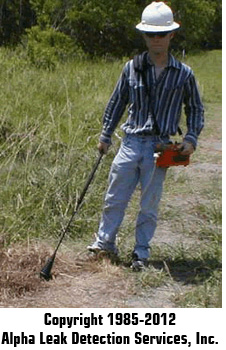Walking in Congested High Consequence Areas is the Only Way to Complete a Thorough and Accurate Combustible Gas Leak Survey!
 Urban growth has placed houses, apartments, hospitals, schools, playgrounds, and churches, at times, only yards away from major gas transmission pipelines.
Urban growth has placed houses, apartments, hospitals, schools, playgrounds, and churches, at times, only yards away from major gas transmission pipelines.
Technology has advanced to include the invention of several vehicle-mounted devices to survey multiple pipelines at one time. These devices are only adequate for surveying long distances of pipelines in remote areas without obstacles such as fences, produce/crop fields, yards, trees, up hillsides, through swamps, wetlands, remote island locations, water, trenches and buildings. The use of these vehicles also relies upon the accuracy of the right-of-ways that tend to shift over time due to changes in mowing and clearing patterns.
Our experience has proven the most thorough method to complete a leak survey of pipelines that traverse through congested urban areas with obstacles such as fences, produce/crop fields, yards, trees, up hillsides, through swamps, wetlands, remote island locations, water, trenches and buildings is to complete the survey on foot.
Combustible Gas Leak Surveys
Alpha offers combustible gas leak surveys using the latest flame ionization and hydrocarbon leak detection equipment.
Since the inception of our company in 1985, our technicians have completed over 5,000 miles worth of surveys in both urban and rural areas. Alpha has completed leak surveys on virtually all classifications of buried pipelines transporting hydrocarbons such as natural gas, propane, ethane, propylene, acetylene, LPG, or liquids that would gasify once in the atmosphere, such as ammonia and hydrogen. Our OQcertified technicians annually complete multiple cross-country leak surveys in excess of 200 miles at a time.
Our procedures require our technicians to electronically locate each pipeline, where necessary, to ensure that they walk and survey the actual pipeline location – thus identifying all potential leaks.
Experience has proven that pipeline markers can’t be trusted as a method of accurately identifying pipeline locations. Markers are sometimes found hundreds of feet away from the actual line because the perceived right-of-ways tend to shift over the years due to changes in mowing and/or clearing patterns.
To assist you in managing your leak survey compliance activities, our internal project scheduling department will:
- Maintain a computer matrix of your pipeline systems that require leak surveys and the associated DOT compliance dates for required completion.
- Notify your regional operations, maintenance or purchasing department within one month of the required activity.
- Dispatch our technicians to the project site upon your approval for project execution.
- Forward a computer-generated written report of the leak survey results with a map of the area surveyed for your
records.
Many of our customers rely on our services to:
- Conduct a thorough and complete survey of the entire transmission system.
- Relieve the crisis of internal resource shortages for personnel needed to complete extremely periodic and time-consuming activities.
- Provide qualified operators of the latest GPS technology and arrive on site with computerized mapping stations to map leak locations and identified irregularities.
Scheduled leak surveys of gas transmission lines are the best method of protecting the lives of people who live and work near them. For that reason, the DOT included several regulations that call for intermittent surveys depending on area population and the content of the transmission line.
DOT Regulations
49 CFR Sec. 192.5 – Class locations.
“Class 1 – Any location that has 10 or fewer buildings intended for human occupancy.”
“Class 2 – Any location that has more than 10 but fewer than 46 buildings intended for human occupancy.”
“Class 3 – Any location that has 46 or more buildings intended for human occupancy; or an area where the pipeline lies within 100 yards (91 meters) of either a building or a small, well-defined outside area that is occupied by 20 or more persons on at least 5 days a week for 10 weeks in any 12-month period.”
“Class 4 – Any location where buildings with four or more stories above ground are prevalent.”
49 CFR Sec. 192.706 – Transmission lines: Leakage surveys.
“Leakage surveys of a transmission line must be conducted at intervals not exceeding 15 months, but at least once each calendar year. However, in the case of a transmission line which transports gas in conformity with Sec. 192.625 without an odor or odorant, leakage surveys using leak detector equipment must be conducted—(a) In Class 3 locations, at intervals not exceeding 7½ months, but at least twice each calendar year; and (b) In Class 4 locations, at intervals not exceeding 4½ months, but at least four times each calendar year.”
Specialty Access Equipment
We maintain an arsenal of specialty equipment including airboats and motorboats that allow our crews to access the most remote pipeline locations. This equipment allows us to conduct our leak surveys in remote areas that are bound by swamps and other bodies of water.
In addition to our arsenal of marine equipment, Alpha owns various 4×4 and 6×6 ATVs for remote right-of-way access. This equipment has allowed our technicians to complete some of the most demanding and time constrained projects in a minimal amount of time.
Estimates and Proposals
To ensure that you are satisfied with the value of our services, our sales staff will produce a detailed price estimate based on all the known conditions of your project and our list of standard charges. This allows you to view the elements of your project estimate in detail before deciding whether to accept our project proposal. Our proposals and service price list are available in electronic form and can be sent via e-mail or faxed upon request.
Click here to discuss your needs with a qualified Alpha associate.



